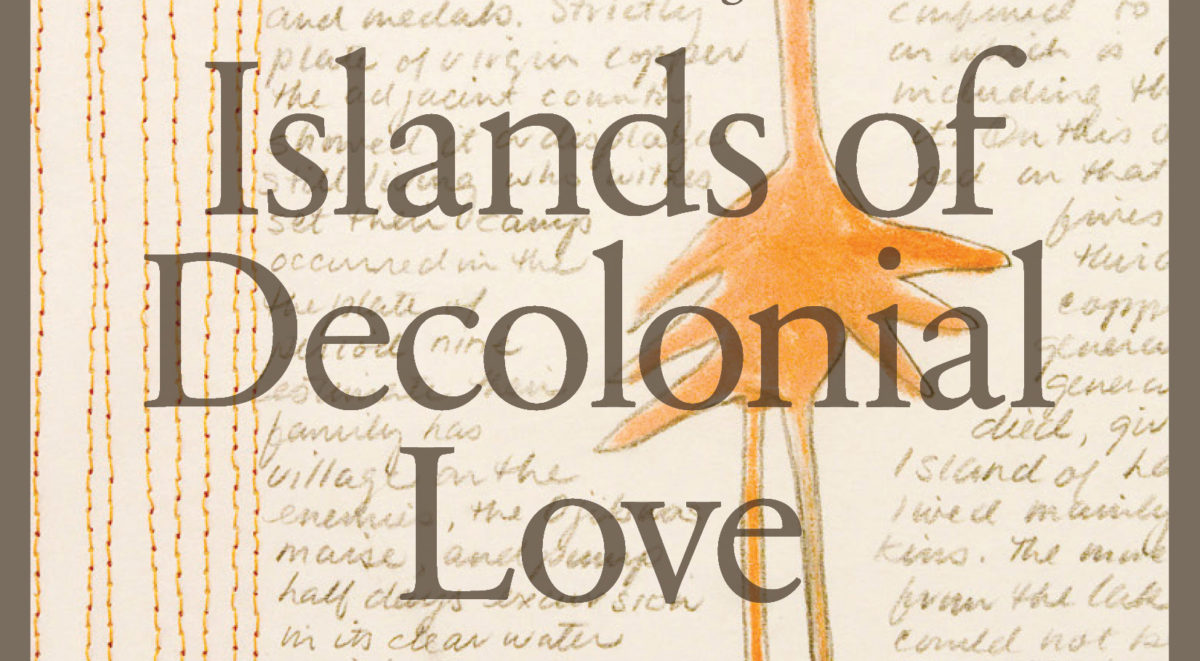
Review by Wendy Bone
Islands of Decolonial Love
by Leanne Simpson
ARP Books, 2016
Leanne Simpson’s Islands of Decolonial Love arrived in the post on a day when I was feeling edgy about the sorry state of the world, with the kind of restlessness you get when you can’t find the right book to read. This collection of poems and stories was just the right remedy. Simpson, an accomplished Indigenous academic from Ontario, Canada (she is Mississauga Nishnaabeg, once known as Ojibwe), and author of Dancing On Our Turtle’s Back: Stories of Nishnaabeg Re-Creation, Resurgence and a New Emergence, has created unforgettable characters who find love in its myriad quiet forms while dealing with the ongoing effects of colonialism.
From 15th century onwards, European settlers arrived on the shores of North America—already known as Turtle Island—bringing death and disease as they waged war against Indigenous people, robbed them of their land and forced them onto reservations. In Canada, approximately 150,000 Indigenous and Métis children were sent to government-run residential schools where they were stripped of their identities and made to dress, act and speak as Europeans. The result has been a devastating disconnection from culture, with repercussions that continue to be felt today, particularly among the younger generations who suffer from a high suicide rate and substance abuse. Along with the degradation of Indigenous people, rampant development and extraction of natural resources continue to destroy the land.
Simpson dives deep into the heart of what it’s like to live under such conditions, yet amazingly, she also shows that an Indigenous revival is emerging from our tragic history. The people of her stories and poems can be found on reservations, in the city or out on the land in Ontario or eastern Canada, often feeling disconnected, but finding moments of love, strength or self-knowledge. The narrator of “indinawemaaganidog/all of my relatives” says her alarm goes off when she’s touched, yet she hugs a Mohawk fisherman who takes her to see a seal colony on the Atlantic coast. Esther, a journalist in “she told him 10,000 years of everything” is suspicious of gentleness or honesty, yet when she goes to a bar to interview a musician passing through town, she recognizes him as a kindred spirit who bears these traits. The narrator in “giiwedinong” has a boyfriend who strikes her so hard she falls in a busy lane of traffic, but rather than falling into a lifetime of abuse, the relationship ends right there.
These are not tragic heroines. Rather, they arise from tragic circumstances to subtly transform and start anew. There’s a little seed of potential buried in each story, and that’s what makes this book so powerfully restorative. Simpson skilfully links the stories and poems together with images that propel them forward and allow these little seeds of hope to grow. A traditional burial in “jiimaanag” becomes a sacred burial site in the next poem, “jiibay or aandizooke”, where white settlers have built their house. Next, in “she told him 10,000 years of everything”, the sense of dislocation continues with Esther living in a makeshift house but that sense transforms into something like hope: “the makeshift feeling was a feeling of being one step closer to escaping—the walls, the house, the city, and she liked that.” (71) Disconnection can even be a sign of strength and survival, like the lynx in “caged” whose pacing is “less coping than a deliberate act to liberate her soul from her body, so she could bask more fully in the vision of her ancestors.” (98)
The seeds of renewal also spring into images of unlocking and activism. My favourite scene is in “pipty”, when a group of activists gather on sacred First Nations land, now a provincial park, gated and locked. While they wait for the key, “this old woman gets out of her truck and…comes out in her rubber boots and she walks right up to the chain link with her bolt cutters and she cuts that chain in half and moves it out of the way.” (46) After a brutal history of land grabs, false promises and environmental destruction, something is happening, a cutting away of the old to make way for the new—and at the forefront are the elders.
To decolonize is to build a future based on new possibilities and ways of thinking, and the best way forward is by listening to the elders. In “lost in a world when he was always the only one“, the narrator interviewed a group of elders for a university project and with what she learned “redrew the maps these old ones kept tucked away in their bones.” (59) Such maps will guide future generations, and the revival of language is key. But it’s not easy; Simpson’s characters must work hard to regain their language by taking courses, reading Ojibwe-English dictionaries and making a conscious effort. This book itself is a dictionary of the Anishinaabe language, with footnotes containing words like gezhizhwazh, to cut, (112) or aabawe wendamoowin, to forgive, to warm up to or loosen ones’ mind, to loosen or unlock one’s feelings. (47)
Whether Indigenous, settlers, or a mixture of both, we can gain much from Simpson’s stories. Some might be painful or unsettling to read. But if we really take the time to listen and understand them and the possibilities they represent, this book, like the rest of Simpson’s work, can “unlock” us, let us grow and move in new directions where Indigenous and non-Indigenous people can work together on equal ground. This is especially important now, when we all face some of the most challenging environmental issues of our time.
Wendy Bone is in UBC’s MFA Creative Writing optional residency program, where she’s currently writing about the environment and her experience as a Sixties Scoop baby. Raised in Vancouver, she is of French and Cree ancestry.